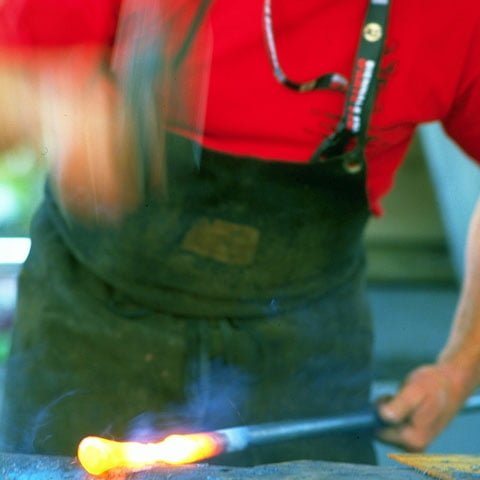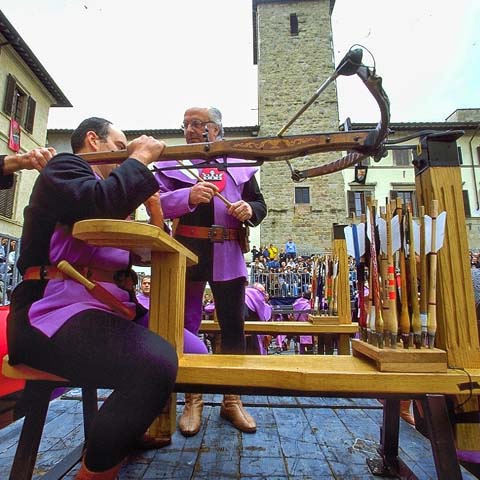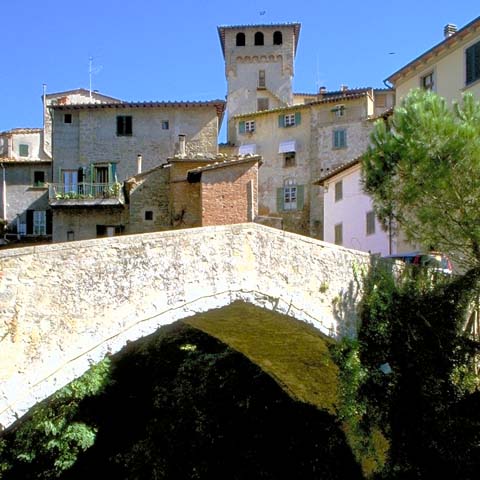The ancient hilltop town of Arezzo can be traced all the way back to the Etruscan Era. Throughout the years, this Italian city thrived and became one of the most affluent towns in Tuscany, all the while perfectly preserving a number of time-honored traditions yet simultaneously introducing modern ones. Arezzo is a charming town that is smaller in size than nearby Florence, but often boasts a nearly comparable amount of culture. Spend a few days of your Italian getaway taking in the medieval architecture, renowned artistic works, local music, and cinematic history of lovely Arezzo.
ARCHITECTURE
One of the best-known churches in Arezzo is that of the Basilica of San Francesco. The circa thirteenth century church is fairly simple on the exterior as it is made of brown stone and boasts two main features of a circular window and a large main doorway. Although it is known for its stunning and detailed interior, the main draw to travelers here tends to be a series of frescoes entitled The Legend of the True Cross, by Renaissance artist Piero della Francesca. This fresco cycle covers quite a bit of wall space and is considered to be one of Piero della Francesca’s most highly revered works.
The Cathedral of San Pietro and San Donato sits in the city’s historic center. The exterior is made primarily of a beige colored sandstone and features a number of arched windows with the façade of the building boasting three arched entryways, a beautiful circular window, and a small cross at the top. The interior of the church is simply stunning with a main arch dedicated to Saint Donatus and intricate ceiling detail.
The Church of Santa Maria della Pieve is another frequently visited religious site in Arezzo. Located in the Piazza Grande, this church has a rather grand presence in the city with a highly detailed exterior that features dozens of columns, stone archways, and a bell tower. The structure is thought to be amongst the oldest churches of the city with origins in circa the eleventh century.
Although not a church, the Medicean Fortress is an excellent example of period architecture. The fortress is estimated to have been built circa the sixteenth or seventeenth century and has a distinct pentagon shape. A walking tour of the fortress is an excellent way to understand the structure’s military strengths and history over the centuries. Those who have the opportunity to stand on the highest walkways of the castle can expect to see breathtaking panoramic views of the city below.
One church with an interesting history is the Church of Santa Maria delle Grazie. This fifteenth century Gothic church was built on top of the site of a miraculous spring that dates back to the Etruscan Era. Saint Bernardino attributed the healing properties of the spring to the Virgin Mary. The structure of the church consists of one nave with cross-vaults, and inside travelers can admire the fresco Pope Sixtus IV Enthroned between Cardinals Gonzaga and Piccolomini.
ART
Giorgio Vasari, a sixteenth century Italian painter, architect and writer, was born in Arezzo. During his career, Vasari became friends with famous artist Michelangelo who heavily influenced his art. Throughout his career, Vasari worked in Florence, Rome, and Naples as he was commissioned to create a number of special pieces throughout Italy. He is best known for writing a biography of artists known as The Lives of the Most Excellent Painters, Sculptors, and Architects, which was first published in 1550.
One of the best-known artists of the Arezzo area was fifteenth century painter Piero di Benedetto, better known as Piero della Francesca. The artist was born in the town of Sansepolcro, which is part of the province of Arezzo. As an Italian painter during the Renaissance, Piero della Francesca painted a number of influential pieces. However, he is perhaps most recognized for his series of frescoes in the Basilica of San Francesco titled The Legend of the True Cross. Although Piero della Francesca is largely known for his artistic contributions to Italy, he was also regarded as well-educated in mathematics and geometry.
Piero della Francesca’s work can be admired throughout Arezzo as well as in his hometown. In fact, Sansepolcro’s Civic Museum houses many of Piero della Francesca’s masterpieces including the Polyptych of Mercy altarpiece, the Resurrection fresco, the San Giuliano fresco, and the San Ludovico fresco.
LITERATURE
One of the earliest authors on record from Arezzo is Francesco Petrarca, referred to as Petrarch in English. This fourteenth century Italian writer of the Renaissance is considered by many to be the founder of humanism. Many of his works have contributed to the foundations of Italian literature. He wrote sonnets that later became well known for their high quality of lyrical poetry. During his career, Petrarca traveled throughout the country and wrote letters often, many of which were written in Latin. His best-known work is widely accepted to be the Canzoniere, or Songbook, which is also believed to have inspired Geoffrey Chaucer.
Pietro Aretino was a sixteenth century Italian playwright and poet born in Arezzo. After his early years, he left for Rome where he began a rather turbulent and problematic career as a writer. Due to the shocking and untraditional nature of some of his works, he was forced to flee his home more than once. Aretino was also known for his unique ability to both flatter and blackmail via a written letter. As a writer, he is largely known best for Sonetti lussuriosi, a collection of provocative sonnets.
MUSIC
In the seventeenth century, writer Giovanni Filippo Apolloni was born in Arezzo. In the following years, he began to write poetry and eventually became a court poet for an archduke of Austria. Eventually, Apolloni’s roots as a poet gave way to a career in writing a number of operas, oratorios, and cantatas.
Perhaps the most famous musical figure of Arezzo is that of tenth and eleventh century poet Guido of Arezzo. He was regarded as one of the foremost musical theorists of the Medieval time period. He is also widely considered to be the inventor of modern musical notation. Originally, Guido was a Benedictine monk, a position that inspired much of his passion for writing music when he realized the singers could not remember Gregorian chants. Guido’s contribution to music has reached far beyond Italy and is still accepted and used today across the globe.
CINEMA
Although much of Tuscany has been used over the years in different films within the movie industry, there is one particular film that is Arezzo’s claim to cinematic fame, Italian director Roberto Benigni’s film La Vita e Bella (1997) (which translates to Life Is Beautiful). Benigni himself was born in the province of Arezzo and the majority of the scenes for the first part of the movie were filmed in Arezzo. Travelers can typically easily identify these areas as the city has erected signs that direct visitors to the specific spots appearing in the movie. The most frequently visited site is Piazza Grande where the famous bicycle scene was originally filmed. If you have never seen La Vita e Bella, watching it before your vacation to Italy should enhance your excitement in visiting these filming locations.
To date, Benigni’s film is perhaps the best known of the city’s cinematic accomplishments, however scenic Arezzo has been featured in other films over the years, such as Quore (2002) and Un fantastic via vai (2013).
SCIENCE
Arezzo was the birthplace of seventeenth century scientist Francesco Redi. The physician and biologist is believed to have been the first to use evidence to counter the theory of spontaneous generation. Within the scientific community, he is known as the “founder of experimental biology” as well as the “father of modern parasitology.
The town of Arezzo is a city of rich tradition that spans centuries and has yielded outstanding global contributions in literature, music, art, and film. Do not let this smaller, less traveled town escape your Italian vacation itinerary, and be sure to bask in the tangible and artistic splendor of the enchanting city of Arezzo.
Travel Guides
The Tuscany Region of Italy
The Cities of Tuscany, Italy
















